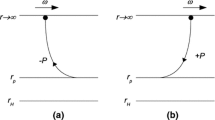Summary
A model is presented for a tachyon and a bradyon bound in circular orbits. They are taken to be charged point particles interacting through action-at-a-distance retarded potentials without radiation reaction. The superluminal Lorentz transformation used conforms to the relativity principle in that it retains the constancy of the speed of light, the forms of Maxwell’s equations and the Lorentz force equation, and requires electric charges to retain their electric character upon transformation from superluminal to subluminal frames. Interactions between a tachyon and a bradyon are restricted to regions within twointeraction cones. Backward cones are related to retarded potentials and forward cones to advanced potentials; this should be taken into account in resolving causal paradoxes. The tachyonium atom consisting of a tachyon-bradyon pair interacting through retarded potentials has discrete values of total energy and angular momentum for a given mass ratio; it is shown that this discreteness does not occur for half-retarded-half-advanced potentials. Values for conserved quantities and other properties are presented. A model that might explain many of the features of quasars is suggested.
Riassunto
Si presenta un modello per un tachione e un bradionc legati in orbite circolari. Questi sono considerati particelle cariche puntiformi che interagiscono mediante potenziali ritardati di azione a distanza senza reazione di radiazione. La trasformazione superluminale di Lorentz usata è conforme al prinipio della relatività nel senso che mantiene la costanza della velocità della luce, le forme delle equazioni di Maxwell e l’equazione di Lorentz della forza, e richiede che le cariche elettriche mantengano il loro carattere elettrico nella trasformazione da un sistema superluminale ad uno subluminale. Le interazioni tra un tachione e un bradione sono limitate alle regioni all’interno dei dueeoni d’inter azione. I coni all’indietro sono correlati ai potenziali ritardati e quelli in avanti ai potenziali avanzati; questo fatto dovrebbe essere tenuto in considerazione nel risolvere i paradossi causali. L’atomo di tachionio che consiste in una coppia tachione-bradione che interagisce mediante potenziali ritardati ha valori discreti dell’energia totale e dell’impulso angolare per un dato rapporto di massa, si mostra che questa discretezza non si verifica per potenziali semiritardati-semiavanzati. Si presentano i valori per quantità conservate e altre proprietà. Si suggerisce un modello che possa spiegare moite delie caratteristiche dei quasar.
Similar content being viewed by others
References
M. N. Kreisler:Am. Sci.,61, 201 (1973);P. N. Bhat, N. V. Gopalakrishnan, S. K. Gupta andS. C. Tonwar:J. Phys. G,5, L13 (1979).
D. F. Bartlett, D. Soo andM. G. White:Phys. Bev. D,18, 2253 (1978).
E. Recami andE. Mignani:Biv. Nuovo Cimento,4, 209 (1974).
Tachyons, Monopoles, and Related Topics, edited by E. Recami (Amsterdam, 1978).
Causality and Physical Theories, edited by W. B. Rolnick (New York, N. Y., 1974).
V. S. Barashenkov:Sov. Phys. Usp.,17, 774 (1975).
J. V. Narlikar andE. C. G. Sudarshan:Mon. Not. R. Astron. Soc,175, 105 (1976).
M. B. Davis, M. N. Kreisler andT. Alväger:Phys. Bev.,183, 1132 (1969).
O. M. P. Bilaniuk, V. K. Deshpande andE. C. G. Sudarshan:Am. J. Phys.,30, 718 (1962);G. Feinberg:Phys. Bev. D,17, 1651 (1978).
L. Parker:Phys. Rev.,188, 2287 (1969).
K. H. Mariwalla:Am. J. Phys.,37, 1281 (1969).
A. F. Antippa andA. E. Everett:Phys. Rev. D,4, 2198 (1971);8, 2352 (1973);A. F. Antippa:Phys. Rev. D,11, 724 (1975);L. Machildon, A. E. Everett andA. F. Antippa:Nuovo Cimento B,53, 253 (1979).
F. Gonzalez-Gascon:Phys. Lett. A,56, 249 (1976);H. Lemke:Nuovo Cimento A,27, 141 (1975);E. Goldoni: in ref. (5).
H. C. Corben:Nuovo Cimento A,29, 415 (1975);Int. J. Them. Phys.,15, 703 (1976).
P. Havas: in ref. (6);L. Basano:Lett. Nuovo Cimento,16, 562 (1976);S. C. Barbowes:Found. Phys.,7, 617 (1977).
M. Pavšič:J. Phys. A,14, 3217 (1981);E. A. B. Cole:Nuovo Cimento,44, 157 (1978).
P. Stephas andH. C. Von Baeyer:Phys. Rev. D,20, 3155 (1979).
H. C. Corben:Lett. Nuovo Cimento,11, 533 (1974);H. C. Corben andE. Honig:Lett. Nuovo Cimento,13, 586 (1975). See also R. Mignani and E. Recami:Lett. Nuovo Cimento,13, 589 (1975).
J. B. Marion:Classical Electromagnetic Radiation (New York, N. Y., 1965), Chapt.7.
A. Schild:Phys. Rev.,131, 2762 (1963).
B. Bruhns:Phys. Rev. D,8, 2370 (1973).
R. A. Rudd andR. N. Hill:J. Math. Phys. (N. Y.),11, 2704 (1970).
P. Stephas:Am. J. Phys.,46, 360 (1978).
C. M. Andersen andH. C. von Baeyer:Am. J. Phys.,39, 914 (1971).
C. M. Andersen andH. C. von Baeyer:Ann. Phys. (N. T.),60, 67 (1970).
M. Walker andC. M. Will:Phys. Rev. D,19, 3483 (1979), and private communication.
H. L. Shipman:Black Holes, Quasars, and the Universe (Boston, Mass., 1980).
T. J. Pearson, S. C. Unwin, M. H. Cohen, R. P. Linfield, A. C. S. Readhead, G. A. Scielstad, R. S. Simon andR. C. Walker:Nature (London),290, 365 (1981);G. Pooley:Nature (London),290, 363 (1981).
Author information
Authors and Affiliations
Additional information
To speed up publication, the author of this paper has agreed to not receive the proofs for correction.
Rights and permissions
About this article
Cite this article
Stephas, P. Tachyonium, an action-at-a-distance model. Nuov Cim A 75, 1–16 (1983). https://doi.org/10.1007/BF02816775
Received:
Published:
Issue Date:
DOI: https://doi.org/10.1007/BF02816775




